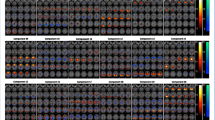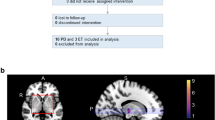Abstract
The effect of stereotactic thalamotomy was assessed with pre- and postoperative functional magnetic resonance imaging (fMRI) under motor stimulation. A patient with unilateral essential tremor (ET) of the left arm underwent stereotactically guided thalamotomy of the right ventral intermediate thalamic nucleus (VIM). FMRI was done directly before and after surgery on a 1.5-Tesla scanner. The stimulation paradigm was maintainance of the affected arm in an extended position and hand clenching being performed in a block design manner. Statistical analysis was done with Brain Voyager 2000. After thalamotomy the tremor diminished completely. As a difference between the pre- and postoperative fMRI, a significant activation was found in the VIM contralateral to the activation site, adjacent to the inferior olivary nucleus contralateral to the activation site and in the dorsal cingulum. In conclusion, fMRI can detect the functional effect of thalamotomy for tremor treatment. Direct postoperative fMRI provides a sufficient method for estimating the effect of thalamotomy immediately after intervention. The importance of the intermediate thalamic nucleus and the olivary nucleus in tremor generation is supported by our findings.



Similar content being viewed by others
References
Findley LJ, Koller WC (1987) Essential tremor: a review. Neurology 37:1194–1197
Salisachs P, Findley LJ (1984) Problems in the differential diagnosis of essential tremor. In: Findley LJ, Capildeo R (eds) Movement disorders: tremor. Macmillan, London, pp 219–224
Helmchen C, Hagenow A, Miesner J, Sprenger A, Rambold H, Wenzelburger R, Heide W, Deutschl G (2003) Eye movement abnormalities may indicate cerebellar dysfunction. Brain 126:1319–1332
Lamarre Y (1984) Animal models of physiological, essential and Parkinsonian-like tremors. In: Findley LJ, Capildeo R (eds) Movement disorders: tremor. Macmillan, London, pp 183–194
Hirai T, Miyazaki M, Nakajima H, Shibazaki T, Ohye C (1983) The correlation between tremor characteristics and the volume of effective lesions in sterotactic nucleus ventralis intermedius thalamotomy. Brain 106:1001–1018
Jenkins JH, Bain PG, Colebatch JG, Thompson PD, Findley LJ, Frackowiack RS, Marsden CD, Brooks DJ (1993) A positron emission tomographic study on essential tremor: evidence for overactivity of cerebellar connections. Ann Neurol 36:82–90
Wills AJ, Jenkins JH, Thompson PD, Findley LJ, Brooks DJ (1994) Red nuclear and cerebellar but no olivary activation associated with essential tremor: a positron emission tomographic study. Ann Neurol 36:636–642
Kwong KK, Belliveau JW, Chesler DA, Goldberg IE, Weisskopf RM, Poncelet BP (1992) Dynamic magnetic resonance imaging of human brain activity during primary sensory stimulation. Proc Natl Acad Sci USA 89:5675–5679
Hertz-Pannier L, Lehericy S, Cordoliani Y, Le Bihan D, Marsault C, Brunelle F (2000) Brain functional MRI: physiological, technical and methodological bases and clinical applications. J Radiol 81:717–730
Rao SM, Binder JR, Bandettini PA, Hammeke TA, Yetkin FZ, Jesmanowicz A et al (1993) Functional magnetic resonance imaging of complex human movements. Neurology 43:2311–2318
Bucher SF, Seelos KC, Stehling MK, Oertel WH, Paulus W, Reiser M (1995) High resolution activation mapping of basal ganglia with functional magnetic resonance imaging. Neurology 45:180–182
Bucher SF, Seelos KC, Dodel RC, Reiser M, Oertel WH (1997) Activation mapping in essential tremor with functional magnetic resonance imaging. Ann Neurol 41:32–40
Rezai AL, Lozano AM, Crawley AP, Joy ML, Davis KD, Kwan CL, Dostrowski JO, Tasker RR, Mikulis DJ (1999) Thalamic stimulation und functional magnetic resonance imaging: location of cortical und subcortical activation of implanted electrodes. J Neurosurg 90:583–590
Talaraich J, Tournoux P (1988) Co-planar stereotactic atlas of the human brain. Thieme, New York
Friston KJ, Holmes AP, Poline JB, Grasby PJ, Williams SC, Frackowiack RS, Turner R (1995) Analysis of fMRI time series revisited. Neuroimage 2:45–53
Pickles JO (ed) (1989) An introduction to the physiology of hearing. Academic Press, London
Hesselmann V, Wedekind C, Kugel H, Schulte O, Krug B, Klug N et al (2001) Functional magnetic resonance imging of the human pontine auditory pathway. Hear Res 158:160–164
Acknowledgement
This work was supported by a grant from Koeln Fortune.
Author information
Authors and Affiliations
Corresponding author
Rights and permissions
About this article
Cite this article
Hesselmann, V., Maarouf, M., Hunsche, S. et al. Functional MRI for immediate monitoring stereotactic thalamotomy in a patient with essential tremor. Eur Radiol 16, 2229–2233 (2006). https://doi.org/10.1007/s00330-006-0211-8
Received:
Revised:
Accepted:
Published:
Issue Date:
DOI: https://doi.org/10.1007/s00330-006-0211-8




